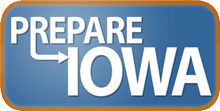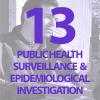


Capability 13: Public Health Surveillance and Epidemiological Investigation
Definition: Public health surveillance and epidemiological investigation is the ability to create, maintain, support, and strengthen routine surveillance and detection systems and epidemiological investigation processes, as well as to expand these systems and processes in response to incidents of public health significance.
Functions and Associated Performance Measures: This capability consists of the ability to perform the functions listed below. Associated CDC-defined performance measures are also listed below.
Function 1: Conduct public health surveillance and detection
Function 2: Conduct public health and epidemiological investigations
Function 3: Recommend, monitor, and analyze mitigation actions
Function 4: Improve public health surveillance and epidemiological investigation systems
The goal of the CASPER Awareness Scenario is to develop a basic understanding of what a Community Assessment for Public Health Emergency Response (CASPER) is and how it can be used following a disaster. This course was developed by the Upper Midwest Preparedness and Emergency Response Center and the Iowa Department of Public Health. It takes about an hour to complete.
 Basic Epidemiology [2]
Basic Epidemiology [2]
There are four modules in this course: 1. Important Terms in Epidemiology 2. Models for Understanding the Infectious Process 3. Epidemiology in Practice 4. Surveillance There are review questions at the end of modules 1 and 2. These review questions will provide you with an opportunity to apply the knowledge and skills presented in these modules. There is a quiz at the end of module 3. In addition, some modules contain practice exercises to help you better understand the material. Upon completion of this course, you will be able to: - Discuss important terms and concepts for basic epidemiology practice. - Describe the inter-related aspects of the infectious disease process and methods of breaking this "chain" of infection. - Understand basic epidemiology in practice, using a case study of a food-borne outbreak as an example. - Perform basic surveillance tasks in an appropriate and timely manner. - Utilize your regional epidemiologist as a resource for outbreak investigations.
Inclusive Just-in-Time Training for Public Health Investigations (PHI) [3]
Inclusive Just-in-Time Training (I-JITT) for Public Health Investigations is a comprehensive and systematic toolkit designed to support individuals leading and responding to a public health emergency. Its approach to training is aligned with best practice from the field of adult learning theory. The toolkit consists of five components: Implementation Instructions for the Preparedness Planner, an Operational Briefing Checklist for the Epidemiology/Surveillance Group Supervisor, a Field Training Guide for Team Leaders (complete with Job Action Sheets), a “Go-Guide” job aide for surge responders to utilize during an incident, and a short evaluation form to evaluate the I-JITT approach. This training was developed by the Multnomah County Advanced Practice Center.
Building a Public Health Community of Practice—A Biosurveillance Resource Compendium [4]
Building a Public Health Community of Practice – A Biosurveillance Resource Compendium is a toolkit intended to help public health agencies implement an effective, comprehensive biosurveillance program. Providing approximately 40 resources, the toolkit ncludes a series of articles on implementing biosurveillance initiatives, materials defining and discussing the development of a public health community of practice, specific examples of real-world tools and resources that have proven beneficial in North Texas (including system response protocols), and a research report on biosurveillance system efficacy.
Community Assessment for Public Health Emergency Response (CASPER) Toolkit [5]
The Division of Environmental Hazards and Health Effects, Health Studies Branch (DEHHE/HSB) at the Centers for Disease Control and Prevention (CDC) has developed the Community Assessment for Public Health Emergency Response (CASPER) toolkit to assist personnel from any local, regional, state, or federal public health departments in conducting the CASPER during disaster. One of the main objectives in developing this toolkit is to standardize the assessment procedures focusing on United States disaster response. The CASPER toolkit provides guidelines on data collection tool development, methodology, sample selection, training, data collection, analysis, and report writing.
Inclusive Just-in-Time Training (I-JITT) for Public Health Investigations [3]
This comprehensive and systematic toolkit is designed to support individuals leading and responding to a public health emergency. Its approach to training is aligned with best practice from the field of adult learning theory. The toolkit consists of five components: Implementation Instructions for the Preparedness Planner, an Operational Briefing Checklist for the Epidemiology/Surveillance Group Supervisor, a Field Training Guide for Team Leaders (complete with Job Action Sheets), a “Go-Guide” job aide for surge responders to utilize during an incident, and a short evaluation form to evaluate the I-JITT approach. This toolkit is designed to be adaptable to the changing environment of an emergency response and includes tips on how to integrate I-JITT into a local response, whether training lasts five minutes or an hour. Any health department interested in adopting the toolkit can access a hard copy of the product at NACCHO’s toolbox or download PDF/MS Word files that can be tailored to meet the needs of a local jurisdiction
National Planning Scenarios [6]
The Federal interagency community has developed 15 all-hazards planning scenarios (the National Planning Scenarios or Scenarios) for use in national, Federal, State, and local homeland security preparedness activities. The Scenarios are planning tools and are representative of the range of potential terrorist attacks and natural disasters and the related impacts that face our nation. The objective was to develop a minimum number of credible scenarios in order to establish the range of response requirements to facilitate preparedness planning.
Links
[1] http://go.prepareiowa.com/url/f4
[2] http://go.prepareiowa.com/url/l7
[3] http://apc.naccho.org/Products/APC20102205/Pages/Overview.aspx
[4] http://apc.naccho.org/Products/APC20081484/Pages/Toolkit.aspx
[5] http://www.emergency.cdc.gov/disasters/surveillance/pdf/CASPER_toolkit_508%20COMPLIANT.pdf
[6] https://secure.nccrimecontrol.org/hsb/planning/Planning%20Documents/National%20Planning%20Scenarios%202006.pdf